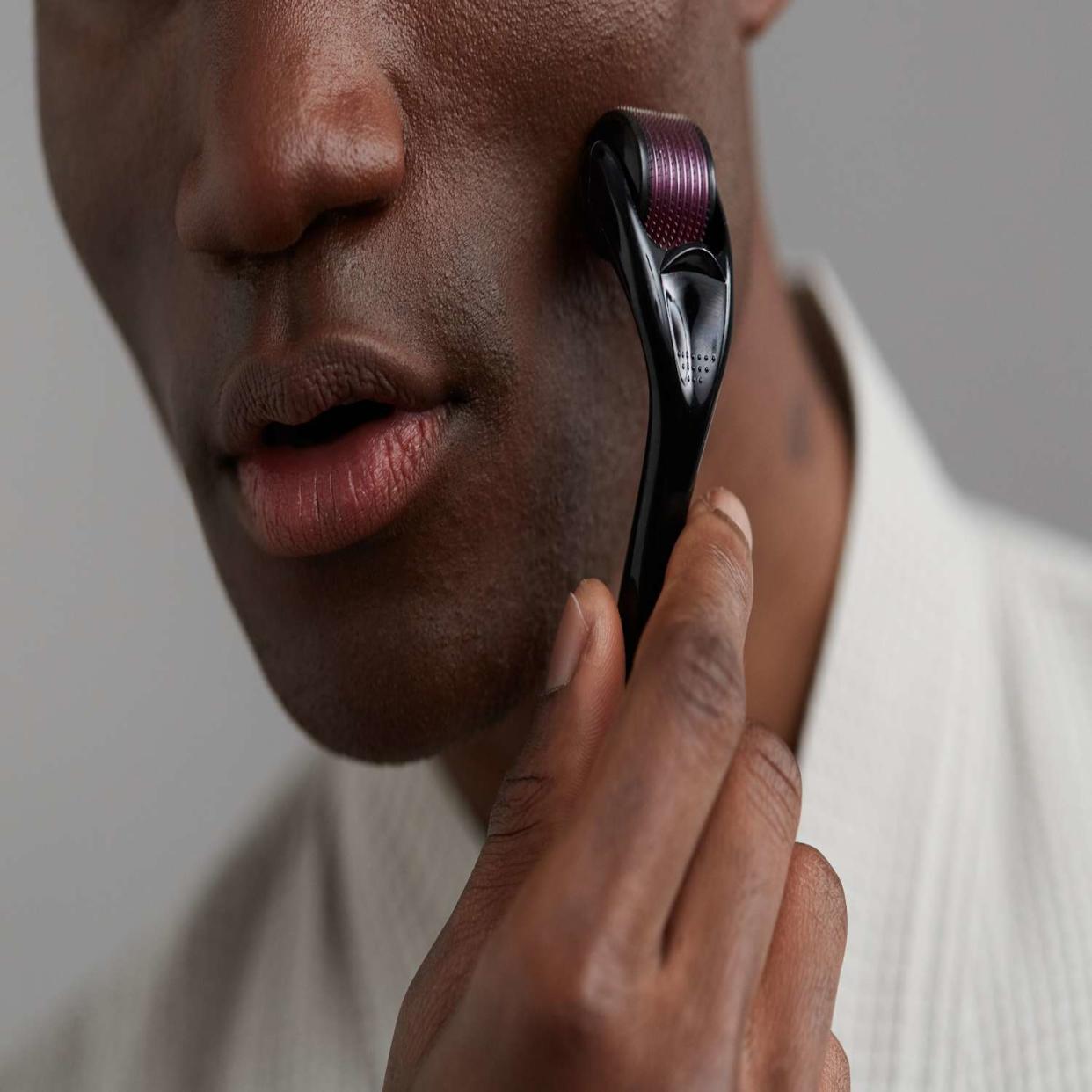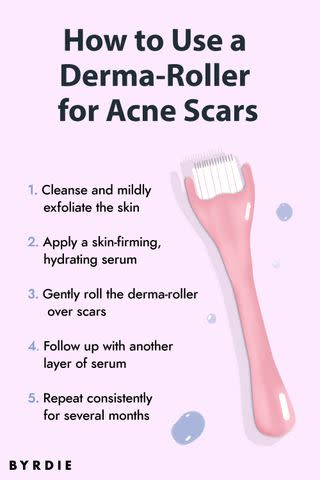How to Use a Derma Roller for Acne Scars, According to Experts

Hugh Sitton / Stocksy
Medically reviewed by Dendy Engelman, MD, FACMS, FAADFact checked by Anna Harris
We've written about the benefits of dermaplaning on Byrdie before. The treatment may help with everything from wrinkles and dark under-eye circles to stretch marks, discoloration, and enhanced product absorption. However, we've never gone into the specifics of what it can do for acne scars. Yet the evidence that this minimally invasive, relatively risk-free procedure (which can be done professionally by a dermatologist or at home with a derma-roller) can help with their appearance is compelling. We tapped dermatologist Dr. Anna Guanche, aesthetician Kerry Benjamin, and plastic surgeon Dr. Andrew Ordon to find out more.
Tips
Dr. Anna Guanche is a celebrity dermatologist and dermatologic surgeon in Calabasas, CA. Her clients include Olivia Culpo and Rebecca Romijn.
Kerry Benjamin is an expert aesthetician and the CEO of Stacked Skincare.
Dr. Andrew Ordon is a plastic surgeon at Visthetic Surgery Institute & MedSpa™ in Los Angeles.
Keep scrolling to learn everything there is to know about using a derma roller for acne scars.
What Is Dermaplaning?
"Dermaplaning helps to reveal undamaged skin, newer skin, and can help the appearance of skin imperfections like acne scars," says Guanche. "It’s a cosmetic procedure on your skin that is minimally invasive."
How It Works
"Dermaplaning works by exfoliating the skin and removing the outer layer, which can help improve the texture and tone of the skin," explains Odin. A derma-roller glides tiny needles over the skin to break down collagen bundles in the top layer of the dermis, which are responsible for those uneven scars. It also stimulates the repair process by immediately boosting the production of more collagen. The result? Plumper, more even skin texture and tone, plus less obvious atrophic acne scars—indented scars that form below the upper layer of skin tissue as a result of severe acne.
"However, it's important to note that dermaplaning may not completely remove or eliminate acne scars," adds Odin. "The effectiveness of dermaplaning for acne scars can vary depending on the individual and the severity of the scars."
Who It's For
Dermaplaning is generally considered safe for all skin types and tones including darker skin tones. "In fact, it can be an effective exfoliation method for darker skin, as it immediately removes dark hairs that can make the skin look dull," says Odin. Dermaplaning can address various skin concerns, from acne scars to dull, dry, and/or sun-damaged skin, as well as fine wrinkles, he adds.
According to Odin, "Dermaplaning is a manual exfoliation technique that does not cause micro-abrasions on the skin, unlike some facial scrubs. It is a gentle and safe procedure that can be performed on virtually every skin tone and type, including sensitive skin."
How to Use a Derma-Roller for Acne Scars

If you plan to try dermaplaning at home, first you'll need a derma-roller—a drum-shaped device with a handle and teeny-tiny stainless steel needles sticking out of it that usually come in sizes between 0.25 and three millimeters long. For first-time users, Odin says Schick's Hydro Silk Dermaplaning Wand ($20) is a great option. He also recommends the Dermaflash Luxe+ Sonic Dermaplaning Set ($199), which utilizes sonic technology for the ultimate precision.
Tips
For shallow acne scars, you'll want a derma-roller with one-millimeter needles, and for deeper scars, one-and-a-half millimeters would be best. For the one-millimeter roller, move through your routine once every 10 to 14 days, and for the one-and-a-half, every three to four weeks.
"Carefully cleanse and dry your face before starting and remember to hold the blade at a 45-degree angle and use gentle, light strokes," instructs Odin. "Avoid applying excessive pressure and always move the blade in the direction of hair growth," he stresses.
To make the treatment even more effective, you can combine it with a complementary serum. After cleansing (but before rolling), try applying a collagen-boosting serum containing ingredients like hyaluronic acid, stem cells, or peptides. According to Benjamin, “These are the types of ingredients that will really maximize the effects of micro-needling to stimulate collagen, speed up cell turnover, lift hyperpigmentation, smooth out fine lines, firm, plump, and hydrate."
"After the treatment, apply a soothing moisturizer or serum and protect your skin from the sun with a broad-spectrum sunscreen," says Odin. "While dermaplaning at home can be safe, follow proper techniques and consult a skincare professional if you have any concerns or uncertainties."
Risks and Side Effects
"It’s best to hold off on dermaplaning if you have active acne, psoriasis, eczema, rosacea, inflamed skin, or if you have a sunburn," advises Guanche. Odin agrees, adding, "It's important to note that dermaplaning should not be performed on active acne-prone skin. If you have active acne, it's best to consult with a skincare professional to determine the most appropriate treatment option for your specific needs."
Dermaplaning vs. Microdermabrasion
"Microdermabrasion is skin exfoliation using a machine that removes the top layer of the skin to reveal new, healthy skin," explains Guanche. "It can help to improve the appearance of the facial scarring, fine lines, and acne, to name a few." Odin adds, "Microdermabrasion involves using a handheld device to exfoliate the skin and remove the outer layer. It uses tiny crystals or a diamond-tipped wand to gently abrade the skin's surface."
"Dermaplaning, on the other hand, uses a surgical scalpel or razor to shave off the top layers of the skin," continues Odin. "It is a manual exfoliation technique that removes dead skin cells and vellus hair (peach fuzz). Dermaplaning can also help improve the texture and tone of the skin, including reducing the appearance of acne scars.
So how do you decide between microdermabrasion or dermaplaning to treat your acne scars? According to Dr. Odin, it's important to consider your skin type, sensitivity, and the severity of the scars when deciding which option is right for you.
Skin Sensitivity
"Dermaplaning is generally considered to be a gentler procedure compared to microdermabrasion, which can be more abrasive," Odin tells us. "If you have sensitive skin or are prone to irritation, dermaplaning may be a better option."
Skin Type
"Microdermabrasion may be more suitable for oily or acne-prone skin, as it can help unclog pores and reduce the appearance of acne," explains Odin. "Dermaplaning, on the other hand, may be beneficial for those with dry or dull skin, as it can help improve skin texture and enhance product absorption."
Treatment Depth
"Microdermabrasion tends to be more aggressive and can penetrate deeper into the skin compared to dermaplaning. If you have deep acne scars, microdermabrasion may provide more significant results," says Odin.
The Final Takeaway
Although derma-rollers are available to use at home, Guanche advises going to an expert if you're considering dermaplaning. "I think it is always best to see a professional when using a sharp blade on your face," she says. "If you cut your face or use an unclean blade, you may get a serious skin infection."
On the other hand, as long as you follow the proper precautions, Odin says that dermaplaning can be done safely at home. "Before attempting the procedure, thoroughly research and understand the technique, risks, and necessary tools. Consulting with a physician who is experienced in dermaplaning can provide valuable guidance and ensure that at-home dermaplaning is suitable for your skin," he tells us. "Using high-quality dermaplaning tools specifically designed for home use is important, and each session should start with a clean and sterilized blade."
Up Next: Dermarolling 101: Everything You Need to Know About Using an At-Home Dermaroller
Read the original article on Byrdie.

